
Natural purifiers in a pot
It may be no wonder that indoor plants have exploded in popularity at the same time we’re growing more aware of the detrimental effects of air pollutants and pathogens on our health—particularly, on our respiratory systems. Science suggests some plants may be able to counteract these effects to make our air cleaner.
For example, one February 2022 study in Air Quality, Atmosphere and Health revealed that three different types of indoor potted plants, grown in different soil mediums, had passively removed various levels of nitrogen dioxide from the air. The study’s authors noted potential dangers of nitrogen dioxide, “with exposure linked to serious respiratory illnesses, decreased lung function and airway inflammation.” The three particular plant species that cut down on nitrogen dioxide were the peace lily, the corn plant, and the ZZ plant. This study helped to back up findings from the 1989 NASA Clean Air Study, which over the years has become a holy grail reference with its then-revolutionary finding that house plants can remove toxins from the air.
The Best Foods for Healthier Lungs, from Pulmonology Doctors and a Dietitian
It’s important to note that some critics of the NASA study, such as the authors of one 2019 review, have suggested you’d need a whole jungle to experience the air-purifying benefits that the NASA researchers observed in the late ’80s. But—along with so many other recently upheld benefits of plants on human health—plants definitely can bring a breath of fresh air to your space.
Here’s the list of plants that science has shown may have purifying effects to the air in your home.

Cornstalk Dracaena
You might be tempted to look for an ear of corn within the leaves of this plant because it really looks like a corn stalk in a pot. It doesn’t yield sweet corn, but science suggests it does help rid your home of toxic agents like formaldehyde, trichloroethylene, and benzene.
The 2022 study also showed that the corn plant reduced nitrogen dioxide in the air when it was grown in moist soil and the “typical” light conditions specified for this plant: bright, indirect light. The reduction of nitrogen dioxide may be beneficial to the respiratory system.
Perhaps best of all, the corn plant doesn’t require too much maintenance—it can reportedly handle the occasional missed watering.

Dragon Tree
The Dragon tree is a relative of the corn plant—and similarly, in the NASA study, dragon trees removed benzene, formaldehyde and trichloroethylene (which may affect the liver, among other hazards) from the air.
Known for being hardy and likewise low-maintenance, these trees are great for a beginner, as well as anyone whose home doesn’t get a ton of sun. The dragon tree can manage in low light conditions.
The 8 Best Indoor Plants for Your Mental Health, Say Wellness Experts
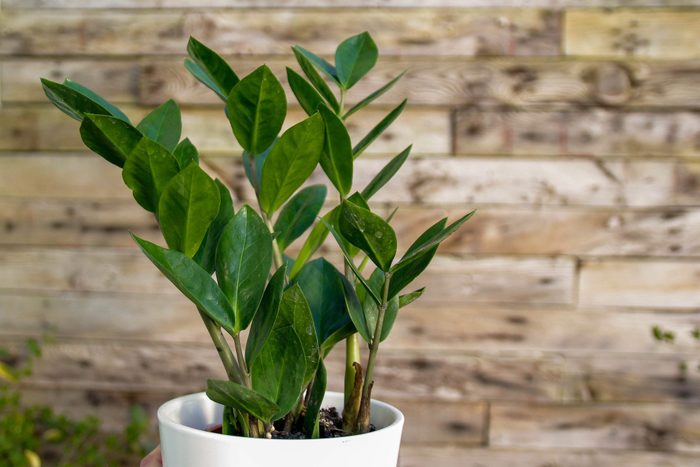
ZZ plant
New to plant parenthood and want a plant that’s beginner-friendly? The ZZ plant (short for its Latin name, Zamioculcas zamiifolia) is your jam.
In the recent study, the ZZ plant reduced nitrogen dioxide from the air when it was grown in optimal conditions: sufficient light and regular watering.
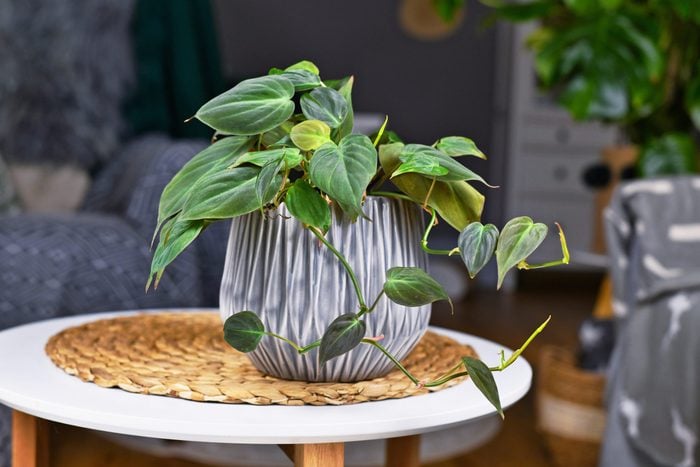
Heartleaf philodendron
With lovely heart-shaped leaves, this philodendron is named for the Latin word for “love.”
In the NASA study, the heartleaf philodendron removed formaldehyde from the air. This is another good houseplant for newbies because it’s low-maintenance: if you forget to water it or place it in low light conditions, this plant is likely to survive just fine.
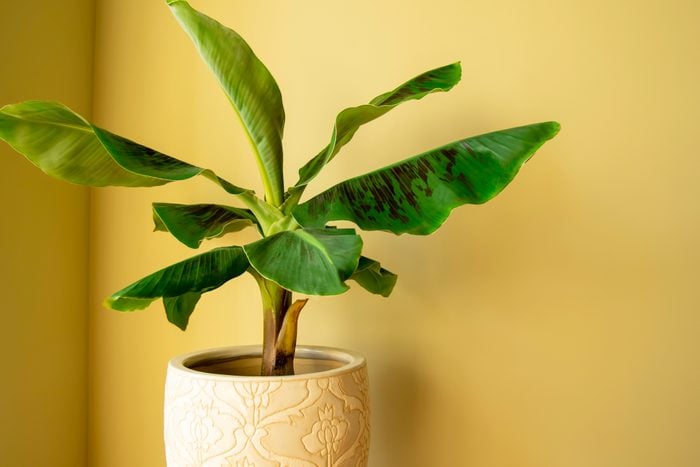
Banana trees
Wanting to add a touch of the tropics to help clear the air? Consider the indoor banana tree, which removed formaldehyde in the NASA study.
Needing plenty of sunlight, banana trees prefer a humid environment, making the bathroom a great home for this plant if you have the space. Or, place it in a sunny location and mist it regularly to keep it happy.
The Banana Health Benefit You for Sure Weren’t Aware of, Dietitians Reveal
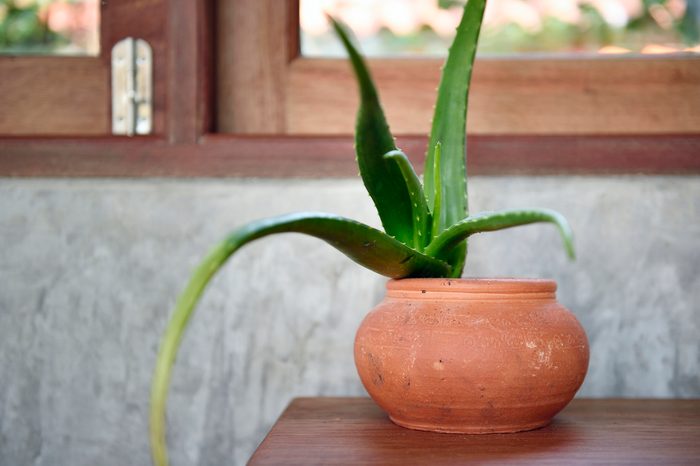
Aloe Vera
A succulent plant that comes in various shades of green and thrives in the sun, Aloe Vera removed formaldehyde while it was kept in a sealed chamber during just a 24-hour period of exposure for the NASA study.
Aloe Vera can also be grown as a houseplant: place it near a sunny window or in a spot that receives direct light and water infrequently.

Dwarf Date Palm
It’s hardy and drought-resistant, but it’s a slow grower. Once this palm matures, it will live for decades and grow eight to 10 feet tall with sharp, needle-like spines arranged near the base of the leaf stem. Take care around them, as they can penetrate through skin and clothing.
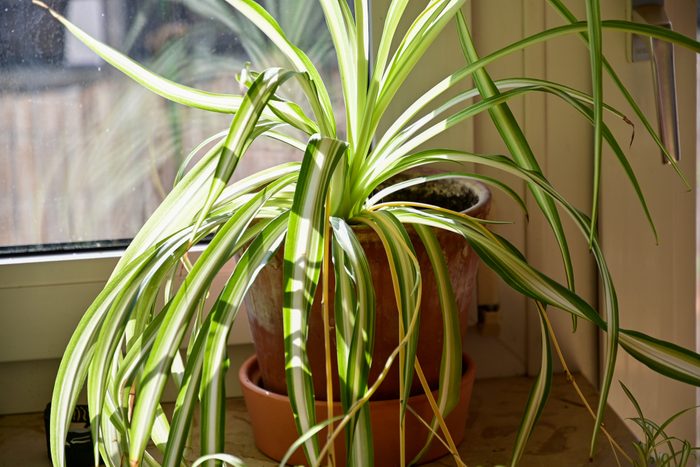
Spider Plant
Talk about a plant that keeps on giving. NASA’s study found that spider plants removed 95 percent of formaldehyde from a sealed plexiglass chamber in 24 hours. Even better, the main plant sends out shoots, called “spiderettes” that flower and eventually grow into baby spider plants that you can transplant.
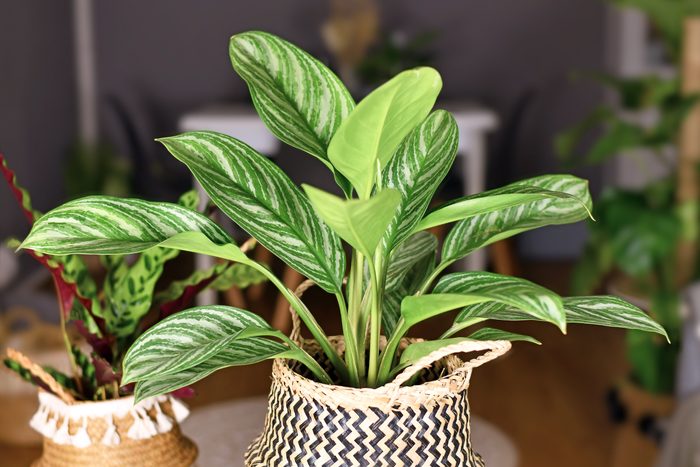
Chinese Evergreen
A sturdy plant that’s easy to keep alive, this one is ideal for your desk or on a living room side table. Its lance-shaped leaves are interspersed with pretty shades of gray, green, and silver. It thrives in low to medium light and is slow-growing—it lives to a ripe old age of 10 years. The evergreen plant filters formaldehyde and benzene based on the NASA study. Just take care if you have pets or young ones: it’s toxic when ingested.

Bamboo Palm
This plant boasts elegance and height, in addition to removing harmful elements like benzene and formaldehyde. Bamboo palms also help keep indoor air moist, making it a welcome addition in dry winter months. Considered a hardy and easy plant to grow, bamboo palms are wonderful for beginners. Bamboo palms love bright, but not direct sunlight and needs monthly fertilizing and regular misting; when it outgrows its container (every two to three years), you’ll need to re-pot it.
10 Surprising Ways Gardening Is One of the Healthiest Things You Can Do

Weeping Fig
According to NASA’s Clean Air Study, the weeping fig is very efficient at cleansing airborne formaldehyde, xylene, and toluene. Xylene and toluene tend to build up from carpet and furniture cleaners and stain removers. Weeping figs are easy to care for, so you can place a couple in each room. Just keep them out of direct sunlight and don’t move them frequently as they tend to drop their leaves when their environment changes and they’ll be a companion for decades. If you own pets, you may want to reconsider bringing this plant into your home because the leaves are toxic for pets if they eat them.
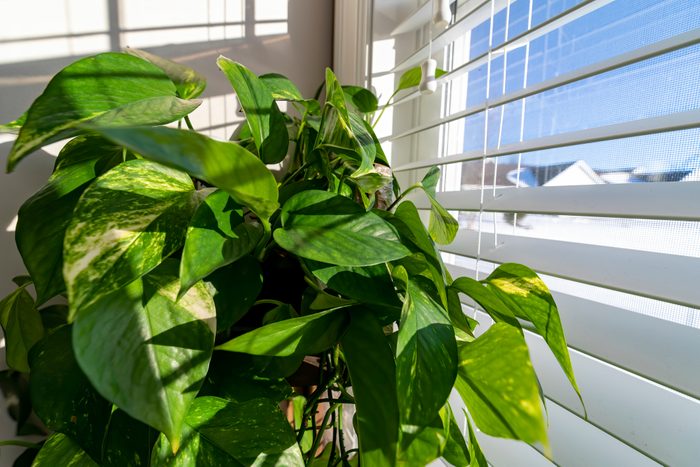
Devil’s Ivy
Devil’s ivy, also known as Pothos, is actually quite angelic. It’s considered one of the most effective indoor air purifiers from benzene, formaldehyde, and xylene. If you’re new to growing house plants, this is a great first plant because Pothos is easy to care for and can tolerate mild neglect, like forgetting to water.
This is a lush, hardy, and vining plant, so it’s great in a hanging basket, where it will trail downwards. In the right conditions, Pothos can grow up to eight feet long and in a variety of directions. Place it in a pot and train it to climb a totem or trellis or place it in a pot on a mantle or coffee table and let it grow horizontally. Do note that devil’s ivy isn’t kind to pets—it’s toxic for them.
An Environmental Psychologist’s 7 Best Home Design Secrets for Less Stress

Broadleaf Lady Palm
You’ve probably seen this lady palm in shopping malls, offices, and hotel lobbies because they tolerate low levels of light. With a maximum height of around six feet, they are perfect as a stately and dramatic feature for the low sunlight corners of your home. They do need regular waterings and moist soil, but you’ll benefit from the plant’s ability to cleanse the air of formaldehyde, ammonia, xylene, and toluene.
‘I Left My Career in the City to Open a Plant Shop—and I’ve Never Been Happier’

Barberton Daisy
These colorful and cheerful daisies were mainly outdoor plants until florists started using them in arrangements. Grown indoors, they can produce flowers at any time of the year, in white, red, orange, pink and purple. The flowers usually last around four to six weeks, but even without the flowers, the Barberton daisy has lush, dark green leaves that are effective at filtering out formaldehyde, benzene, and trichloroethylene. They are happiest with full sun and plenty of water and well-drained soil.

English Ivy
If you work in a salon or do at-home salon treatments with keratin, hair coloring, perms, hair-straightening, nail polish, or nail polish hardeners, consider placing some English ivy in the room. It filters out four toxic agents—trichloroethylene, formaldehyde, benzene, and xylene, which are found in these salon products. A hardy plant that can tolerate low light in intermittent watering, it looks lovely in a hanging basket with vines trailing over the side.
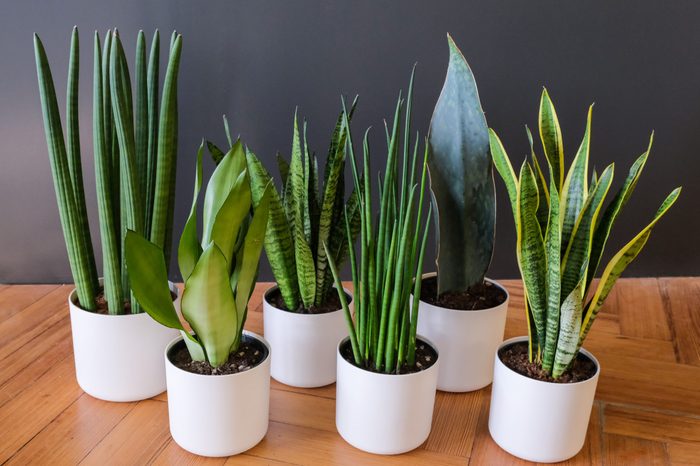
Snake Plant
Snake plants, also known as Mother-in-law’s tongue, are considered hard to kill and are easy to care for, making them great plants for a beginner. Because this plant needs humidity, it’s perfect for your bathroom—the right place for it to filter out the formaldehyde in cleaning products, facial tissues, toilet paper, and hair treatments and dyes. If you remember to mist it, the snake plant is also a nice addition to your bedroom because it gives off oxygen at night—a sleeping aid. But if you have pets, you may want to think twice since the leaves are toxic, if eaten.
The 8 Best Indoor Plants for Mental Health, Say Wellness Experts

Red-Edged Dracaena
For people planning home improvements, start by investing in some red-edged dracaena plants. It is rated as one of the best plants for removing trichloroethylene, found in some home improvement materials such as paint removers and strippers, adhesives, varnish remover, and aerosol degreasers. Conveniently, these plants are sold at home improvement stores. They’re easy to grow and maintain and will reach about 10 feet tall with a spread of three feet. The red-edged dracaena can live for decades under the right care.

Peace Lily
One species of peace lily, Spathiphyllum wallisii ‘Verdi,’ was tested in three different environments and removed nitrogen in similar amounts in the 2022 study.
The hidden talent behind the lush and beautiful peace lily is its excellent air filtering system. It boasts a high transpiration rate—that means the peace lily carries a lot of water from the roots to the leaves and releases moisture back into the room.
If you want to encourage pretty white flowers, place it in a spot that gets indirect light and keep the soil damp but not soggy. Make sure to mist the leaves once a week or so.

Florist’s Chrysanthemum
While technically not a houseplant, these bright, colorful blossoms are usually abundant in stores in the fall and adorn porch steps with their seasonal sidekick pumpkins. But you may want to bring some indoors: they knocked down levels of all the harmful pollutants NASA studied.
Decorate for fall and place mums anywhere in your home where they can get not-too-warm bright sunlight. Water them often and deadhead the flowers to keep the plant looking healthy, and you’ll be able to enjoy blooms for six to eight weeks.
Check out The Healthy on Facebook, Instagram, and Twitter. Read on:
- Singer-Songwriter Jewel Opens Up About Her Painful Past—And What It Took to Heal
- Eating These Foods Can Lead to Premature Death, Says New Study
- What Are the Heart-Healthiest Foods? A Cardiologist Just Opened Her Fridge to Reveal Them
- 9 Ordinary Things in Your Home That Can Damage Your Lungs
Lauren David contributed reporting to this story.

